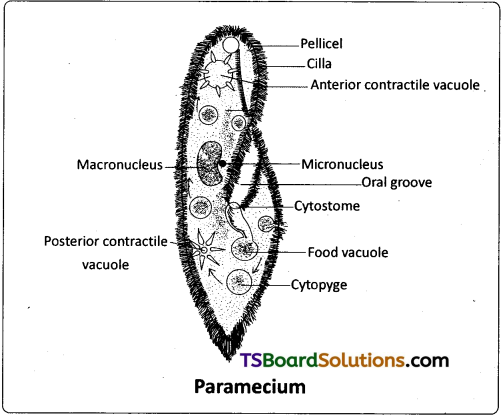Telangana TSBIE TS Inter 1st Year Zoology Study Material 5th Lesson Locomotion and Reproduction in Protozoa Textbook Questions and Answers.
TS Inter 1st Year Zoology Study Material 5th Lesson Locomotion and Reproduction in Protozoa
Very Short Answer Type Questions
Question 1.
Draw a labelled diagram of T.S. of flagellum. [March 2018-A.P.]
Answer:
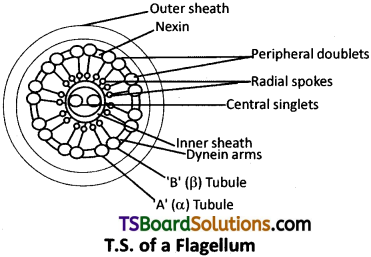
Question 2.
List any two differences between a flagellum and a cilium. [Mar. 2020, ’19, 17 – A.P ; May/June, Mar. 2014]
Answer:
| Flagellum | Cilium |
| 1) The long whip-like locomotor organelles are called flagella. Found in Mastigophoran Protozoans. | 1) These are small hair-like structures found in ciliate protists, genital ducts, respiratory tract. |
| 2) Flagellum helps only in locomotion. | 2) Cilia serve as organelles or locomotion, food collection and also act as Sensory structures. |
| 3) Flagella perform undular movement. | 3) Cilia perform pendular movement. |
![]()
Question 3.
What are dynein arms? What is their significance? [May 2017 – A.P.]
Answer:
In cross section of flagellum / cilium Dynein arms are seen. The ‘A’ tubule of flagellum/ cilium of each peripheral doublet bears paired arms along its length, called dynein arms
Bending movement of a flagellum is brought about by the sliding of microtubules past each other due to the functioning of ‘dynein arms’.
Question 4.
What is a Kinety? [March 2014]
Answer:
A longitudinal row of kinetosomes together with Kinetodesmata constitute a unit called ‘Kinety’.
Question 5.
Distinguish between synchronous and metachronous movements.
Answer:
1) Synchronous movement :
Cilia in a transverse row beat simultaneously in one direction. It is called synchronous movement.
2) Metachronous movement :
The sequential movement of Cilia, in a longitudinal row, one after the other in one direction is called metachronous movement.
Question 6.
Why do we refer to the offspring, formed by asexual method of reproduction, a clone? [March 2020, 19]
Answer:
The term clone is used to describe morphologically and genetically similar daughter individuals formed from single parent by asexual reproduction. They are not only identical to one another but also exact copies of their parent.
Question 7.
Distinguish between proter and opisthe. [Mar. 2017, 13 – A.P ; Mar. 2015 A.P & T.S]
Answer:
During Transverse binary fission of paramecium, two daughter paramecia are formed. The upper or anterior one is proter which receive upper contractile vacuole, cytopharynx and cytostome of its parent. The lower or posterior daughter is opisthe which receives the posterior contractile vacuole only.
Question 8.
How is sexual reproduction advantageous in evolution?
Answer:
Because of the fusion of male and female gametes, sexual reproduction results in offspring that are not identical to the parents or amongst themselves. This leads gradually to origin of new species in course of evolution.
![]()
Question 9.
Distinguish between lobopodium and filopodium. Give an example to each of them. [May ’17 ; March 2015 – A.P.]
Answer:
a) Blunt finger like pseudopodia are called lobopodium and are seen in Amoeba and Entamoeba.
b) Fibre like pseudopodia are called filopodiurn and are seen in Euglypha.
Question 10.
Define conjugation with reference to ciliates. Give two examples. [March 2018 – A.P.; March 2015 – T.S ; May/June 2014]
A. Conjugation is a temporary union between two senile ciliates that belong to two different mating types for the exchange of nuclear material and its reorganization. This is observed in Paramecium and Vorticella.
Short Answer Type Questions
Question 1.
Name the system that controls the fastest swimming movement of protozoans and write its components.
Answer:
The system that controls the fastest swimming movement of protozoans is infraciliary system.
It is located just below the pellicle in the ectoplasm of a ciliate. It includes kinetosomes, kinetodesmal fibrils and kinetodesmata. The kinetosomes are present at the bases of cilia in transverse and longitudinal rows. The kinetodesmal fibrils are connected to the kinetosomes and run along the right side of each row of kinetosomes as a ‘cord of fibres’ called kinetodesmata. A longitudinal row of kinetosomes together with kinetodesmata constitute a unit called ‘kinety’.
All the kineties together form an infraciliary system, which is connected to a ‘motorium’, located near the cytopharynx. The infraciliary system and motorium form the ‘neuromotor system’ that controls and coordinates the movement of cilia.
Question 2.
Write the mechanism of bending of flagellum and explain effective and recovery strokes.
Answer:
Bending movement of flagella: Dynein arms show a complex cycle of movements using energy provided by ATP (dynein arms are the sites of ATPase activity in the cilia and flagella). The dynein arms of each doublet attach to an adjacent doublet and pull the neighbouring doublet. So the doublets slide past each other in opposite directions. The arms release and reattach a little farther on the adjacent doublet and again ‘puli’. As the doublets of a flagellum or cilium are physically held in place by the radial spokes, the doublets cannot slide past much. Instead they curve and cause bending of flagellum or cilium. Such bending movements of flagella and cilia play an important role in the flagellar and ciliary locomotion.
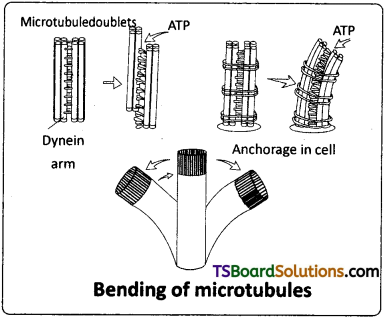
i) Effective stroke :
Flagellum becomes rigid and starts bending to one side beating against the water. This beating against water is at right angles to the body axis and the organism moves forwards.
ii) Recovery stroke :
Flagellum becomes comparatively soft so as to offer least resistance to water and moves backwards to its original position. It is called ‘recovery stroke’.
![]()
Question 3.
What are lateral appendages? Based on their presence and absence, write the various types of flagella giving at least one example for each type. [Mar. 17 – A.P ; Mar. 15 – A.P & T.S]
Answer:
Lateral appendages :
Some flagella bear one or two or many rows of short, lateral hair like fibrils called lateral appendages. They are of two types namely ‘mastigonemes’ and ‘flimmers’.
Types of Flagella :
Based on the presence or absence and / or the number of rows of lateral appendages, five types of flagella are recognised.
a. Stichonematic :
This flagellum bears one row of lateral appendages on the axoneme. Eg : Euglena and Astasia.
b. Pantonematic :
This flagellum has two or more rows of lateral appendages on the axoneme. Eg: Peranema and Monas.
c. Acronematic :
This type of flagellum does not bear lateral appendages and the terminal part of the axoneme is naked without the outer sheath at its tip.
Eg: Chlamydomonas and Polytoma.
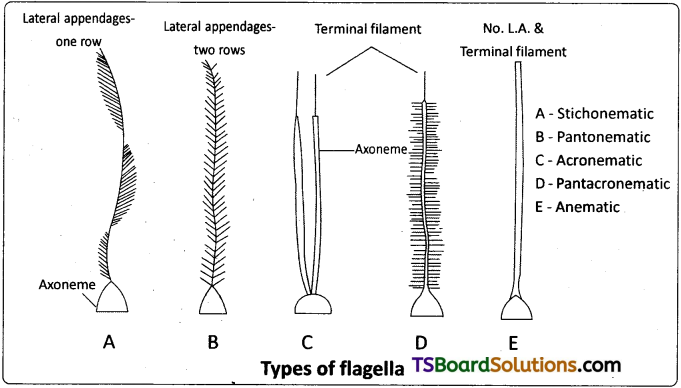
d. Pantacronematic :
This type of flagellum is provided with two or more rows of lateral appendages and the axoneme ends in a terminal naked filament.
Eg. Urceolus.
e. Anematic or simple :
In this type of flagellum, lateral appendages and terminal filament are absent. Hence, it is called anematic (a – no; nematic – threads).
Eg: Chilomonas and Cryptomonas.
Question 4.
Describe the process of transverse binary fission in paramecium. [May 2017 – A.P.; May/June 2014]
Answer:
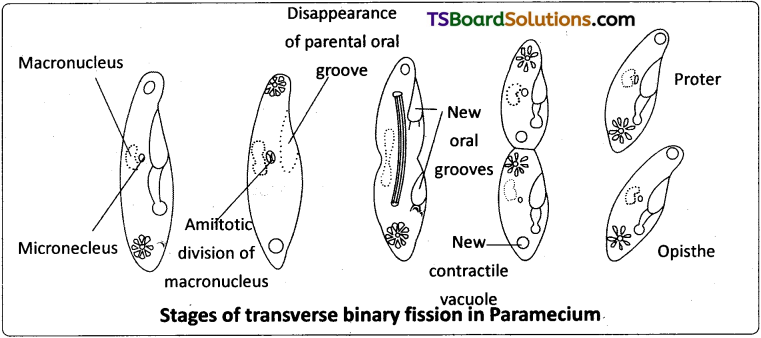
During favourable conditions, Paramecium stops feeding after attaining its maximum growth. At first the micronucleus divides by mitosis and the macronucleus divides into two daughter nuclei by amitosis. The oral groove disappears. After karyokinesis, a transverse constriction appears in the middle of the body, which deepens and divides the parent cell into two daughter individuals, the anterior proter and the posterior opisthe. The proter receives the anterior contractile vacuole, cytopharynx and cytosome from its parent individual.
It develops posterior contractile vacuole and a new oral groove. The opisthe receives the posterior contractile vacuole of its parent. It develops a new anterior contractile vacuole, cytopharynx, cytostome and a new oral groove. Binary fission is completed in almost two hours, in favourable conditions and paramecium can produce four generations of daughter individuals by binary fission in a day.
The transverse binary fission is also called homothetogenic fission, because the plane of fission is at right angles to the longitudinal axis of the body. As it occurs at right angles to the kineties, it is also called perkinetai fission.
Question 5.
Describe the process of longitudinal binary fission in Euglena. [March 2018 – A.P.; March 2014]
Answer:
During the process of binary fission, the nucleus, basal granules, chromatophores, cytoplasm undergo division. The nucleus divides by mitosis into two daughter nuclei. Then the kinetosomes and the chromatophores also divide. At first, a longitudinal groove develops in the middle of the anterior end. This groove extends gradually towards the posterior end until the two daughter individuals are separated.
One daughter Euglena retains the parental flagella. The other daughter individual develops new flagella from the newly formed basal granules. The stigma, paraflagellar body and contractile vacuole of the parent disappear. They develop afresh in both the daughter euglenae. The longitudinal binary fission is known as symmetrogenic division, because the two daughter euglenae resemble each other like ‘mirror images’.
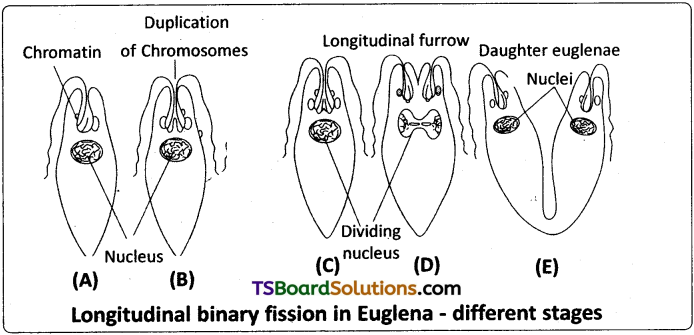
Question 6.
Write a short note on multiple fission.
Answer:
Multiple Fission :
It is the division of the parent body into many smaller individuals (Multi – many; Fission – splitting). Normally multiple fission occurs during unfavourable conditions. During the multiple fission, the nucleus first undergoes repeated mitotic divisions without cytokinesis. This causes the formation of many daughter nuclei. Then the cytoplasm also divides into as many-number of bits as there are nuclei. Each cytoplasmic bit encircles one daughter nucleus. This results in the formation of many smaller individuals from a single parent organism.
There are different types of multiple fissions in protozoans such as schizogony, male gametogony, sporogony in Plasmodium, sporulation in Amoeba, etc.
![]()
Question 7.
Give an account of pseudopodia.
Answer:
Pseudopodia :
These are found in rhizopods. The pseudopodia are temporary extensions of cytoplasm that develop in the direction of the movement. These temporary structures are useful to move on the substratum as our legs do, hence the name ‘pseudopodia’. There are four kinds of pseudopodia namely lobopodia (blunt finger-like) as in Amoeba and Entamoeba, filopodia (fibre-like) as in Euglypha, reticulopodia (net-like) as in Elphidium and axopodia or heliopodia (sun ray-like) as in Actionophrys.
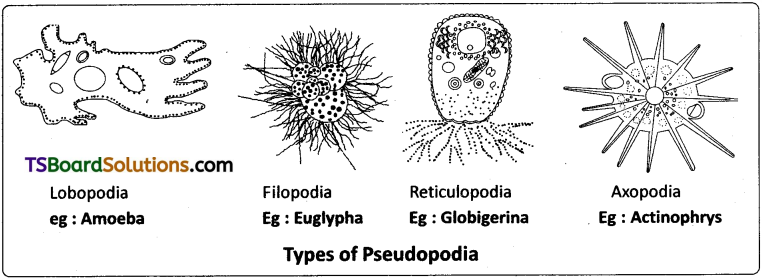
The Pseudopodium is formed by the conversion of gel (viscous outer endoplasmic part) to sol (fluid-like inner endoplasmic part) and vice-versa. There are different theories on the formation of pseudopodium. The sol-gel transformation theory is the most accepted theory. Pseudopodial movement is performed by Amoeba, Polystomella, Actionophrys.
Question 8.
Give an account of the ultra structure of an axoneme.
Answer:
The structural components of a typical flagellum include axoneme, microtubules, dynein arms, inner sheath, outer sheath, radial spokes, lateral appendages (such as mastigonemes or flimmers) and a basal granule (kinetosome).
i) Axoneme / axial filament :
It is the central, longitudinal, microtubular structure of cilium and flagellum. It is surrounded by a membrane which is continuous with plasma membrane. All the components of the axoneme are embedded within the matrix.
ii) Microtubules :
An axoneme is made up of 2 central ‘singlets’ and 9 peripheral ‘doublets (9+2 array)’. These are formed by the protein, tubulin. Each peripheral doublet consists of an outer ‘A’ (alpha) and the inner ‘B’ (beta) tubules, so, the peripheral tubules are actually 9 microtubular doublets. (The microtubule ‘A’ is smaller but complete whereas ‘B’ is larger and incomplete). The peripheral doublets are interconnected by linkers called nexins.
iii) Dynein arms :
The ‘A’ tubule of each peripheral doublet bears paired arms along its length, called dynein arms (Dyne – pulling like a dynamo). The dynein arms of ‘A’ tubule face the tubule ‘B’ of the adjacent doublet. They are oriented in the same direction (clockwise) in all microtubules, when the axoneme is viewed from the base to the top. The dynein arms are considered ‘protein motor molecules’. They are made of the protein, dynein.
iv) Inner and outer sheaths :
The two central singlets are enclosed by a fibrous inner sheath and the peripheral doublets are enclosed by an outer sheath (an extension of plasma membrane). The central singlets do not reach below the level of the pellicle or plasmalemma.

v) Radial spokes :
They are elastic fibres that connect the inner sheath, with the ‘A’ tubule of each doublet. They resemble the spokes that connect the rim of a bicycle wheel with the centre, hence the name ‘radial spokes / radial bridges’. The nine radial spokes limit the extent of sliding past of the doublets, during bending movements.
Question 9.
Draw a neat labelled diagram of Euglena.
Answer:
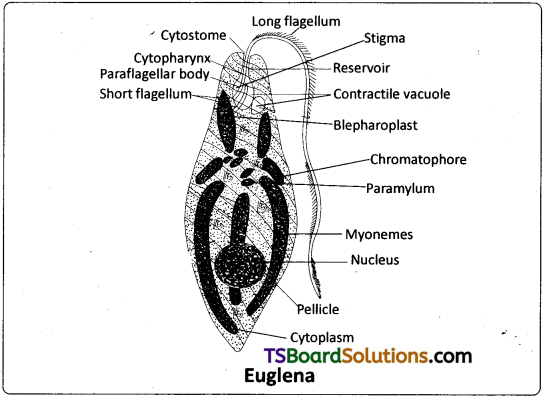
![]()
Question 10.
Draw a neat diagram of Paramecium and label its important structures/components.
Answer:
